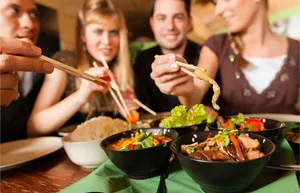In the age of globalization, our taste buds have become more adventurous than ever. As borders blur and cultures intertwine, the culinary landscape has transformed into a global playground for food enthusiasts. The desire to explore the rich tapestry of flavors, techniques, and traditions from around the world has led to a burgeoning trend – international culinary at home.
This concept has gained immense popularity, resonating with individuals who seek to broaden their culinary horizons and savor the diverse offerings of global gastronomy. The allure of international culinary exploration at home lies in its accessibility and inclusivity. No longer confined to the realms of professional chefs or well-traveled foodies, this trend invites everyone to partake in a culinary adventure without the need for a passport.
It transcends geographical limitations, bringing the world’s kitchens into yours, fostering a sense of connection and unity through the shared language of food. As we embark on this culinary journey, we not only discover new flavors but also gain a deeper appreciation for the cultural contexts that shape each dish.
International culinary exploration becomes a celebration of diversity, allowing us to understand the stories and traditions behind the recipes. It’s a testament to the fact that food is a universal language, capable of bridging gaps and fostering cross-cultural understanding. As you embark on this culinary journey, let the shared experiences at the dining table weave a tapestry of connection, turning your kitchen into a global gathering place for flavors, stories, and shared humanity.
Setting the Foundation – Essential Ingredients
Dive into the world of international cuisine, and your pantry will become a treasure trove of possibilities. Start by acquainting yourself with the rich tapestry of spices and condiments that characterize different regions. In Middle Eastern cooking, for instance, cumin, coriander, and cardamom are the aromatic trinity that imparts depth and warmth to dishes like falafel and shawarma.
These spices, with their earthy and citrusy notes, transform a simple meal into a culinary journey through the bustling markets of Marrakech or the aromatic kitchens of Lebanon. Venture further into the East, and you’ll encounter the umami-rich essentials of Japanese cuisine. Soy sauce, with its salty depth, rice vinegar, adding a delicate acidity, and miso, a fermented soybean paste, are the cornerstones of this culinary tradition.
These ingredients not only elevate the taste but also embody the harmony and balance intrinsic to Japanese culinary philosophy. Understanding the significance of each ingredient goes beyond their flavors alone. It involves recognizing the cultural and historical context they carry. For example, saffron isn’t just a spice; it’s a precious thread that weaves through the culinary history of Persian and Indian cuisines, symbolizing opulence and tradition.
The art of combining these diverse elements lies not just in the blending of flavors but in creating a symphony of cultures within your kitchen. Each spice, sauce, or condiment becomes a brushstroke on the canvas of your culinary exploration, allowing you to paint vivid pictures of faraway places with the strokes of a whisk or the toss of a spatula.
Mastering Techniques – The Art of Culinary Fusion
Cooking styles and techniques, as diverse as the cultures they hail from, offer a gateway to understanding the soul of a cuisine. The precision and elegance of French culinary techniques, such as the art of soufflé-making or the mastery of a perfectly executed béarnaise sauce, showcase the dedication to craft that defines French gastronomy.
These meticulous methods emphasize the importance of patience and attention to detail, creating dishes that are not only delectable but also a testament to culinary artistry. On the other side of the culinary spectrum, Asian cooking introduces a dynamic and lively approach. Wok-tossed flavors in Chinese cuisine, for instance, bring a unique texture and smokiness to dishes.
The delicate dance between sweet, sour, salty, and umami flavors in Japanese cooking highlights the precision and balance that are at the heart of their culinary philosophy. Mastering these techniques requires an understanding of the subtleties within each style, allowing home cooks to infuse their creations with an authenticity that respects and honors the cultural origins of the dishes. This fusion of culinary techniques is not about erasing cultural distinctions but rather celebrating them in a shared space.
It encourages a creative, open-minded approach to cooking that goes beyond traditional boundaries. As home cooks embark on this journey of exploration, they become not only chefs in their own kitchens but also ambassadors of cultural exchange through the medium of food. In blending the meticulousness of French culinary traditions with the boldness of flavors from across the globe, a new narrative of culinary creativity unfolds, allowing for a richer and more interconnected understanding of the world through the universal language of food.
Recipes from Around the World – A Culinary Passport
Diving into specific recipes is where the magic truly happens, as it opens a gateway to the heart of a culture. Consider whipping up a classic Italian pasta carbonara, where the simplicity of ingredients, such as eggs, pancetta, and Parmesan, transforms into a symphony of flavors that harmonize with each twirl of pasta. The technique of emulsifying the egg with hot pasta water creates a creamy sauce that is both comforting and indulgent, reflecting the essence of Italian comfort food.
Venturing into the intricate world of Indian curries is a sensory delight. The careful blend of spices, such as cumin, coriander, and garam masala, creates layers of taste that dance on your palate. Each region in India boasts its own unique spice blend, making the exploration of curry recipes a fascinating journey into the diverse culinary landscape of the subcontinent.
Whether it’s the fiery vindaloo of Goa or the aromatic biryanis of Hyderabad, each dish tells a story of tradition, history, and regional identity. This culinary experimentation not only introduces you to new flavors but also enhances your skills as a home chef. It fosters a sense of confidence in the kitchen, allowing you to navigate the intricacies of global cuisines with ease.
The satisfaction derived from successfully executing a challenging recipe is unparalleled, and each triumph contributes to your culinary repertoire. In essence, the exploration of international recipes becomes a culinary education, a delightful fusion of tradition and innovation. So, immerse yourself in the world of recipes waiting to be discovered – each dish is a cultural ambassador, and every preparation is a celebration of the rich tapestry of global cuisine.
Creating a Culinary Atmosphere – Beyond the Plate
To elevate the dining experience further, delve into the art of table presentation. Each culture has its own aesthetic when it comes to arranging a table, and paying attention to these details enhances the overall immersion. Take, for example, the intricate and colorful ceramics often associated with Mexican cuisine. Incorporating vibrant plates and bowls, inspired by Talavera pottery, can add a visually striking element to your table setting.
Similarly, for a French-themed dinner, opt for classic white tableware with elegant linens to capture the sophisticated essence of French dining. Extend the cultural experience to the tableware itself. Using traditional utensils or serving dishes authentic to the cuisine adds a tactile element that connects you more deeply to the culinary roots.

Enjoying sushi with chopsticks or savoring Indian curry with a traditional brass thali can make the meal feel like a genuine exploration into the heart of the cuisine. Extend the cultural experience to the tableware itself. Using traditional utensils or serving dishes authentic to the cuisine adds a tactile element that connects you more deeply to the culinary roots.
Enjoying sushi with chopsticks or savoring Indian curry with a traditional brass thali can make the meal feel like a genuine exploration into the heart of the cuisine. Furthermore, consider involving friends and family in your culinary journey. Turn your international dinners into social events, inviting loved ones to share in the experience.
Conclusion
Moreover, the benefits of engaging in international culinary exploration at home extend beyond the delight of taste. This culinary journey becomes a bridge to connect with people and traditions from different corners of the globe. As you delve into the intricacies of a particular dish, you gain a deeper understanding of its cultural significance and historical roots. Cooking becomes a cultural exchange, a way to appreciate the diversity that makes our world so vibrant.
In a time when travel may be limited, the kitchen emerges as a portal to a myriad of cultures. Each dish tells a story, and each bite is a step into a different world. So, as you embark on this culinary journey, remember that it’s not just about creating delicious meals – it’s about celebrating the shared human experience, one recipe at a time. Your kitchen becomes a stage for cultural celebration, and your cooking skills transform into a passport, allowing you to explore the richness of the world without leaving the comfort of your home.


